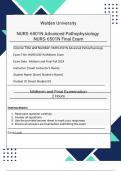Chamberlain University
Walden University
NUR
NURS- 546 Psychopharmacology
6501N for the
Advanced Pathophysiology
Psychiatric-
NURS- Mental
6501NHealth
FinalNurse
Exam Practitioner
NUR 546 Final
Course Title and Number: NURS-6501N Advanced Pathophysiology
Course Title and Number: NUR 546 Psychopharmacology for the
Exam Title: NURS-6501N
Psychiatric-Mental HealthMidterm Exam
Nurse Practitioner
ExamExam
Date: Title:
Midterm
NURand
546Final
FinalFall 2024
Instructor:
Exam [Insert Instructor’s
Date: Final Name]
Exam 2024- 2025
Student Name: [Insert
Instructor: [InsertStudent’s Name]
Instructor’s Name]
Student ID: [Insert
Student Name:Student
[InsertID]
Student’s Name]
Student ID: [Insert Student ID]
Midterm and Final Examination
2 Hours
Final Examination
180 minutes
Instructions:
1.Instructions:
Read each question carefully.
2. Answer all questions.
1. Read each question carefully.
3. Use the provided answer sheet to mark your responses.
2. Answer all questions.
4. Ensure all answers are final before submitting the exam.
3. Use the provided answer sheet to mark your responses.
4. Ensure all answers are final before submitting the exam.
Good Luck!
Good Luck!
Downloaded by Jack mah
(mungaidavid2000@gmail.com)
,NURS- 6501N Advanced Pathophysiology Week 7 & 8:
Neurological and Musculoskeletal disorders NURS-
6501N Final Exam Review with Verified Solutions |
100% Pass | Graded A+ |
Guaranteed Success
Final exam review
Week 7 & 8: Neurological and Musculoskeletal
disorders
Osteoporosis- Postmenopausal osteoporosis occurs in
middle-aged and older women and is caused by increased
osteoclast activity (probably caused by changes in
osteoprotegerin), decreased IGF levels, a combination of
inadequate dietary calcium intake and lack of vitamin D
Decreased levels of estrogen and testosterone, reduced
physical activity lessens muscle stress on bone,
inadequate vitamins C and D, insufficient dietary
magnesium and calcium, corticosteroid use
Osteomyelitis- Osteomyelitis is a bone infection caused
most often by bacteria (e.g., S. aureus) that can enter
bone from outside the body (exogenous osteomyelitis) or
from infection sites within the body (hematogenous
osteomyelitis)
Most often a staphylococcal infection, contaminated open
wound, or hematogenous bone infection.
Acute inflammation of marrow and cortex; impaired blood
supply leads to necrosis that forms a sequestrum and an
involucrum that surrounds the infected bone
Downloaded by Jack mah
(mungaidavid2000@gmail.com)
,Myelomenigocele - Myelomeningocele, or spina bifida
cystica, is a herniation of the meninges, spinal fluid, a
portion of the spinal cord, and nerves through a vertebral
defect; 80% are located in the lumbosacral region. The
Arnold-Chiari malformation is a serious association with
myelomeningoceles that displaces the cerebellar tonsils
downward and can result in cysts within the spinal cord.
Seizures- during infancy and childhood may be the result
of asphyxia, intracranial bleeding, CNS infection, fever,
electrolyte imbalance, or inborn errors of metabolism.
Febrile seizures between ages 6 months and 5 years are
usually benign. Many seizure disorders are idiopathic,
having no known cause. Epilepsy is a neurologic condition
characterized by a predisposition to recurrent seizures.
The incidence of epilepsy varies greatly with age and
likely occurs during infancy or childhood in 0.5% to 1% of
children; the incidence decreases with age.
A seizure is a sudden, explosive disorderly discharge
of cerebral neurons and is characterized by a sudden,
transient alteration in brain function, usually involving
motor, sensory, autonomic, or psychic clinical
manifestations and an alteration in one’s level of arousal.
The alteration in level of arousal is temporary. Among the
causes of seizure activity are the following: metabolic
defects motor syndromes congenital malformations
infections genetic predisposition brain tumors perinatal
injury vascular diseases postnatal trauma fever
Downloaded by Jack mah
(mungaidavid2000@gmail.com)
, Partial seizures (unilateral) were previously termed
jacksonian or psychomotor seizures.
They are now classified as simple, complex, or
secondary. Simple are without impairment of
consciousness, but have somatosensory, autonomic,
psychic symptoms. Complex seizures have impaired
consciousness with or without automatism. Secondary
seizures evolve into generalized tonic-clonic seizures.
Generalized seizures (bilateral) were earlier termed petit-
mal or grand mal. They are now classified as absence,
mycoclonic, clonic, or tonic-clonic. An aura is a sensation,
such as a light, a taste, warmth, or a sound, that precedes
a generalized seizure. A prodroma is a set of early
manifestations, such as malaise or headache, that may
precede the onset of a seizure.
Spinal cord injuries- Spinal cord injuries occur most
often as a result of vertebral injuries. Traumatic forces
injure the vertebral or neural tissues by compressing the
tissue, pulling or exerting traction on the tissue, or
shearing tissues so that they slide into one another
Ankylosing spondylitis- . is characterized by stiffening
or fusion of the spine
is a chronic, inflammatory joint disease characterized by
stiffening and fusion or ankylosis of the spine and
sacroiliac joints.
common symptoms of early ankylosing spondylitis are
low back pain and stiffness
Autonomic hyperreflexia- Autonomic hyperreflexia
(dysreflexia) is a syndrome of sudden massive reflex
sympathetic discharge associated with spinal cord injury
at level T5-T6 or above and can cause life-threatening
hypertension.
Downloaded by Jack mah
(mungaidavid2000@gmail.com)




